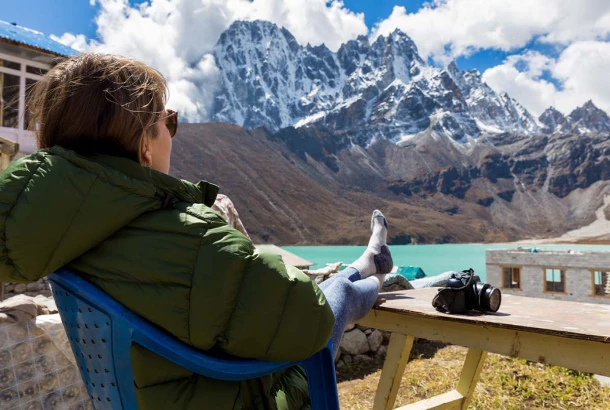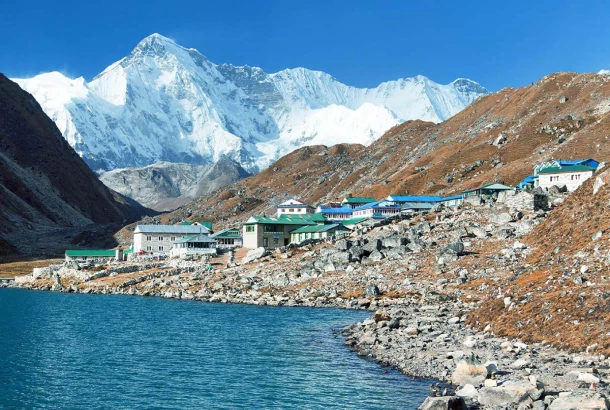Nepal’s Geography and landscape

Sandwiched between two giants, India and China- Nepal is a small country. But within this space is the tallest mountain in the world- Mt. Everest (8848.86 m.), one of the highest lakes in the world- Tilicho (4920m), and the deepest gorge in the world- the Kali Gandaki Gorge.
As a result, the geographical diversity is incredible.
The beauty of Nepal may be impossible to describe in a single piece of writing. The distinctive topography comes first. Nepal is divided into three geographical regions; the Himalayas, the hills, and the plains, with the lowest point being 59 meters and the highest point being 8848.86 meters.
The largest mountains on Earth are located in the Himalayas. The terrain below is mountainous, with hills covered with thick green vegetation. Further down to the south are the lowlands of the Terai region, the haven of fertile lands.
Combining these three geographical regions, you get a bundle of extreme beauty in Nepal. Trekking under these mountains is a dream many people wish to fulfill.
Treks like the "Everest Base Camp Trek, the Annapurna Circuit Trek, the Langtang region Trek, and the Manaslu Circuit Trek", among others, give you a taste of Nepal's magnificence. Both the lowlands and the hills offer a unique taste.
Best Short Trekking Routes in Nepal
Trekking in Nepal has 2 and 3-weeks best hiking routes: Everest Panorama Trek, Annapurna Ghorepani Poon Hill Trek, Everest Base Camp Heli Trek, Mohara Danda Trek, Sarangkot Hiking, Langtang Valley Trek, Khopra Danda Trek, Langtang Tamang Heritage Trek, Chisapani Nagarkot Hike.
As well, the best tours in Nepal are the "Nepal City Tour, Buddhist Pilgrimage Tour, Chitwan Jungle Safari", and many more day hikes with Everest scenery Flights.
Best Trekking Routes in Nepal

The Himalayan country has many different trekking routes, among them here your Reliable Tour Trekking company listed the main trek routes. Here, we listed the best trekking routes, which are avoided the Camping and tea-house-based hiking routes.
Everest Base Camp Trek-16 Days
Annapurna Circuit Trek-20 Days
Everest Gokyo Valley Trek-13 Days
Nar-Phu Valley Trek-12 Days
Manaslu Circuit Trek-16 Days
Upper Mustang Trek-17 days
Everest Gokyo-Ri Trek-18 Days
Langtang Gosaikunda Trek-16 days
Everest Three Passes Trek-19 Days
Adventure Sports
Many people travel to Nepal since there are so many adventurous options. Among these are bungee jumping, paragliding, white water rafting, expeditions, trekking, hiking, and Peak Climbing in Nepal. These activities quench your thirst for thrill and give you the adrenaline rush you desire.
Nepal is undoubtedly the primary reason for travelers to visit Nepal. Eight of the ten highest mountains lie here in Nepal, including Everest (8848.86m), Kanchenjunga (8586m), Lhotse (8516m), Makalu (8481m), Cho Oyu (8188m), Dhaulagiri (8167m), Manaslu (8163m), and Annapurna (8091m) from this esteemed list.
Climbing these peaks is undoubtedly on a bucket list of a lot of climbers. However, people can also enjoy trekking peaks at lower elevations, mostly 6000 m. Most of the time, permits are required for climbing; however, some peaks, like Mardi Himal, do not.
Nepal’s Wildlife
Nepal has 208 mammals, 230 fish, 867 birds, and 651 butterfly species. Asiatic elephants, Bengal tigers, snow leopards, one-horned rhinoceroses, golden Mahseer, and Ganges River dolphins are just a few notable big species.
Likewise, there are also elusive cute animals such as the Red Pandas and Pangolin, along with beautiful birds such as Pheasants, Monal, Peacock, etc.
Additionally, several species are only found in Nepal, such as the bird - spiny babbler; the fish – Nepalese snow trout, Rara snow trout; frog – Rara Lake frog, etc.
So, you can witness a lot of species here in Nepal as you stroll through different landscapes in Nepal.
Nepal’s Unique Culture and Diversity
The natural beauty of Nepal may be a key attraction for travelers worldwide, but the cultural aspect is also appealing. Nepal is home to multiple religions and numerous cultures.
While traveling in Nepal, one can easily experience many cultures. The cultural diversity of Nepal is best reflected in the lifestyle, social beliefs, traditional norms, language, and art spread across the country.
Hinduism and Buddhism predominantly influence the cultures of Nepal. Other cultural traditions followed in the nation include Islam, Shamanism, Kirants, and Christianity. As a result, the cultural ethos of the entire nation is diverse and unique.
Since the nation thrives on culture, a few norms have set the moral grounds of Nepal. Social norms include respect for elders, loving young ones, and taking off one's shoes before entering a religious shrine or home.
One City, One Culture

Nepal also has a rich cultural heritage. The major cities of Nepal, such as Kathmandu, Pokhara, Chitwan, Dharan, Biratnagar, and a few others driven by modernization. However, these cities were built amidst ancient cultural heritages.
Take, for example, Kathmandu, the capital city of Nepal. You can find seven of Nepal's ten UNESCO world heritage sites in the valley. Places like Boudhanath, Swayambhunath, Pashupatinath, etc., hold tremendous cultural and religious values for everyone.
Another prominent example is Lumbini, the birthplace of Lord Buddha. Lumbini is honored by Buddhists around the world as the center of Buddhism.
Festivals of Nepal also truly reflect the widespread culture and tolerance among these cultures.
All cultures celebrate colorful and joyous festivals all year round. Dashain, Tihar, Holi, Chhath, Lhosar, Buddha Jayanti, Christmas, and Eid are some of the major festivals of Nepal.
People of Nepal
Numerous ethnic communities have lived and thrived for thousands of years in the country. These ethnicities have their customs and traditions. Regardless of origin, race, caste, or class, tolerance among people is classic.
In the north of Nepal, Sherpas and Tibetan descendants are common. Rai, Gurung, Brahmin, and Chhetri primarily reside in the hills. In the south, Musahar and Tharu ethnicity live.
In eastern Nepal, the Kirants communities are dominant. While Gurung, Tamang, and Magar peoples live in central Nepal.
Further west, Thakuri, Chhetri, and Thakali dominate most of the population. These are but a few examples of the people living in Nepal.
In Nepal, 125 different ethnic groups have been recorded.
The friendly nature of Nepalese has been known far and wide. But on top of it all, Nepalese people are famous for their hospitality to their guests. Their kind gestures and broad smiles will immediately put you at ease.
You will feel at home thanks to the hospitality of the people of Nepal. Whether in a 5-star hotel in the city or a small tea house in the Himalayas, the kindness remains the same.
Why Nepal is so beautiful?
The gigantic great Himalayan ranges, land-located country Nepal, Eight out of ten highest snow-capped mountains all around the world. unique one hundred twenty-five ethnic groups and cultures Nepal is a beautiful country in the world.
Co-existence of Nature, Culture, and People
Each aspect is dependent on the other, which makes Nepal one of the most incredible places to visit to see the natural beauty of Nepal. This is something that attracts thousands of travelers across the world. While you explore it, the people you encounter enhance your experience with their hospitality and kindness.
The culture provides knowledge that is not available elsewhere. Nepal is the ideal destination whether you want to go on an adventure, learn more profound stories of the culture, or relax in the tranquil nature.
Conclusion
Why Tourist Visit Nepal has a wide variety of natural and cultural attractions. Nepal will never fail to surprise you wherever you go. This wonderful country includes fascinating locations rich in Nepalese natural beauty, cultural majesty, and humbleness. reliable Tour Trekking Company in Nepal best organizes your vacations to outdoor activities.








